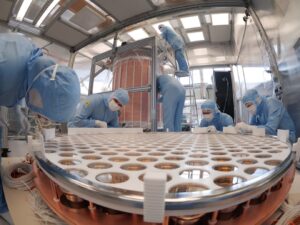
First results of XENONnT on Electron Recoils events

XENONnT researchers assemblying one of the two PMT arrays (front) and working on the TPC (back)
Credit: XENONnT Collaboration
On July 22nd during the IDM 2022 Conference (https://indico.cern.ch/event/922783/) held in Vienna, the XENONnT Collaboration announced its first results on Electron Recoils events.
The XENONnT detector at the Gran Sasso Laboratory in Italy replaces the previous one, XENON1T. XENONnT aimed not only to enlarge the detector mass (5.9 t active volume from 2 t) but improve significantly the background identification and rejection exploiting new techniques and an active neutron veto. Details on the detector can be found here: XENON Collaboration, JCAP 11 (2020) 031.
XENONnT took the first science data over 97.1 days, from July 6 to November 10, 2021.
The Electron Recoils (ER) events measurement has allowed XENONnT to probe the excess observed by XENON1T at 2.3 keV (ER energy). XENONnT has reached an unprecedented low level of radon of order 2 μBq/kg. The low background achieved allows XENONnT to use rare signal, such as the double-electron capture on 124Xe, as validation tool. The first data has allowed XENONnT to probe that the detector is performing well, to cancel the excess at low energy, which was due to 3H, and to probe the neutrino magnetic moment with unprecedented sensitivity to 6.3×10-12 μB.
The paper is available on the arxiv and directly here (pdf) . Slides as they were presented at the IDM conference are also available here (pdf).
After searching for Electron Recoils, XENONnT data taking will focus on searching for WIMPs.
For more information please check the XENON website.




